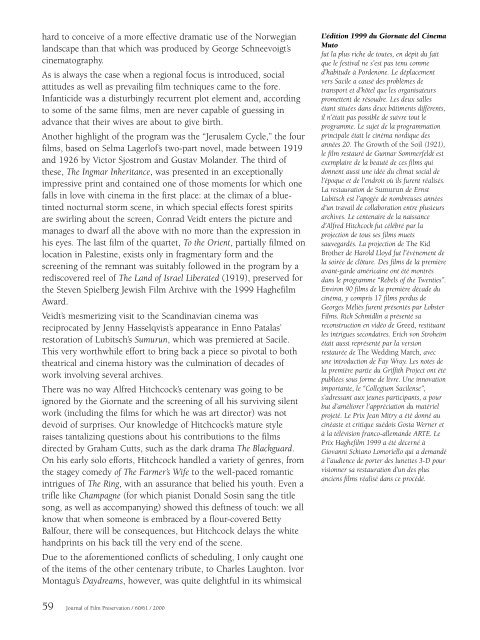Journal of Film Preservation N° 60/61 - FIAF
Journal of Film Preservation N° 60/61 - FIAF
Journal of Film Preservation N° 60/61 - FIAF
You also want an ePaper? Increase the reach of your titles
YUMPU automatically turns print PDFs into web optimized ePapers that Google loves.
hard to conceive <strong>of</strong> a more effective dramatic use <strong>of</strong> the Norwegian<br />
landscape than that which was produced by George Schneevoigt’s<br />
cinematography.<br />
As is always the case when a regional focus is introduced, social<br />
attitudes as well as prevailing film techniques came to the fore.<br />
Infanticide was a disturbingly recurrent plot element and, according<br />
to some <strong>of</strong> the same films, men are never capable <strong>of</strong> guessing in<br />
advance that their wives are about to give birth.<br />
Another highlight <strong>of</strong> the program was the “Jerusalem Cycle,” the four<br />
films, based on Selma Lagerl<strong>of</strong>’s two-part novel, made between 1919<br />
and 1926 by Victor Sjostrom and Gustav Molander. The third <strong>of</strong><br />
these, The Ingmar Inheritance, was presented in an exceptionally<br />
impressive print and contained one <strong>of</strong> those moments for which one<br />
falls in love with cinema in the first place: at the climax <strong>of</strong> a bluetinted<br />
nocturnal storm scene, in which special effects forest spirits<br />
are swirling about the screen, Conrad Veidt enters the picture and<br />
manages to dwarf all the above with no more than the expression in<br />
his eyes. The last film <strong>of</strong> the quartet, To the Orient, partially filmed on<br />
location in Palestine, exists only in fragmentary form and the<br />
screening <strong>of</strong> the remnant was suitably followed in the program by a<br />
rediscovered reel <strong>of</strong> The Land <strong>of</strong> Israel Liberated (1919), preserved for<br />
the Steven Spielberg Jewish <strong>Film</strong> Archive with the 1999 Haghefilm<br />
Award.<br />
Veidt’s mesmerizing visit to the Scandinavian cinema was<br />
reciprocated by Jenny Hasselqvist’s appearance in Enno Patalas’<br />
restoration <strong>of</strong> Lubitsch’s Sumurun, which was premiered at Sacile.<br />
This very worthwhile effort to bring back a piece so pivotal to both<br />
theatrical and cinema history was the culmination <strong>of</strong> decades <strong>of</strong><br />
work involving several archives.<br />
There was no way Alfred Hitchcock’s centenary was going to be<br />
ignored by the Giornate and the screening <strong>of</strong> all his surviving silent<br />
work (including the films for which he was art director) was not<br />
devoid <strong>of</strong> surprises. Our knowledge <strong>of</strong> Hitchcock’s mature style<br />
raises tantalizing questions about his contributions to the films<br />
directed by Graham Cutts, such as the dark drama The Blackguard.<br />
On his early solo efforts, Hitchcock handled a variety <strong>of</strong> genres, from<br />
the stagey comedy <strong>of</strong> The Farmer’s Wife to the well-paced romantic<br />
intrigues <strong>of</strong> The Ring, with an assurance that belied his youth. Even a<br />
trifle like Champagne (for which pianist Donald Sosin sang the title<br />
song, as well as accompanying) showed this deftness <strong>of</strong> touch: we all<br />
know that when someone is embraced by a flour-covered Betty<br />
Balfour, there will be consequences, but Hitchcock delays the white<br />
handprints on his back till the very end <strong>of</strong> the scene.<br />
Due to the aforementioned conflicts <strong>of</strong> scheduling, I only caught one<br />
<strong>of</strong> the items <strong>of</strong> the other centenary tribute, to Charles Laughton. Ivor<br />
Montagu’s Daydreams, however, was quite delightful in its whimsical<br />
59 <strong>Journal</strong> <strong>of</strong> <strong>Film</strong> <strong>Preservation</strong> / <strong>60</strong>/<strong>61</strong> / 2000<br />
L’édition 1999 du Giornate del Cinema<br />
Muto<br />
fut la plus riche de toutes, en dépit du fait<br />
que le festival ne s’est pas tenu comme<br />
d’habitude à Pordenone. Le déplacement<br />
vers Sacile a causé des problèmes de<br />
transport et d’hôtel que les organisateurs<br />
promettent de résoudre. Les deux salles<br />
étant situées dans deux bâtiments différents,<br />
il n’était pas possible de suivre tout le<br />
programme. Le sujet de la programmation<br />
principale était le cinéma nordique des<br />
années 20. The Growth <strong>of</strong> the Soil (1921),<br />
le film restauré de Gunnar Sommerfeldt est<br />
exemplaire de la beauté de ces films qui<br />
donnent aussi une idée du climat social de<br />
l’époque et de l’endroit où ils furent réalisés.<br />
La restauration de Sumurun de Ernst<br />
Lubitsch est l’apogée de nombreuses années<br />
d’un travail de collaboration entre plusieurs<br />
archives. Le centenaire de la naissance<br />
d’Alfred Hitchcock fut célébré par la<br />
projection de tous ses films muets<br />
sauvegardés. La projection de The Kid<br />
Brother de Harold Lloyd fut l’événement de<br />
la soirée de clôture. Des films de la première<br />
avant-garde américaine ont été montrés<br />
dans le programme “Rebels <strong>of</strong> the Twenties”.<br />
Environ 90 films de la première décade du<br />
cinéma, y compris 17 films perdus de<br />
Georges Méliès furent présentés par Lobster<br />
<strong>Film</strong>s. Rick Schmidlin a présenté sa<br />
reconstruction en vidéo de Greed, restituant<br />
les intrigues secondaires. Erich von Stroheim<br />
était aussi représenté par la version<br />
restaurée de The Wedding March, avec<br />
une introduction de Fay Wray. Les notes de<br />
la première partie du Griffith Project ont été<br />
publiées sous forme de livre. Une innovation<br />
importante, le “Collegium Sacilense”,<br />
s’adressant aux jeunes participants, a pour<br />
but d’améliorer l’appréciation du matériel<br />
projeté. Le Prix Jean Mitry a été donné au<br />
cinéaste et critique suédois Gosta Werner et<br />
à la télévision franco-allemande ARTE. Le<br />
Prix Haghefilm 1999 a été décerné à<br />
Giovanni Schiano Lomoriello qui a demandé<br />
à l’audience de porter des lunettes 3-D pour<br />
visionner sa restauration d’un des plus<br />
anciens films réalisé dans ce procédé.
















